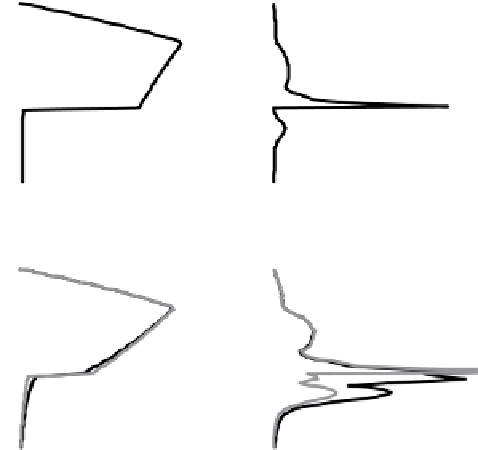Geoscience Reference
In-Depth Information
Eddy Viscosity
Buoyancy Flux: <w'b'>
Eddy Viscosity
BuoyancyFlux <w'b'>
0
0
b
a
-
10
-
10
-
20
-
20
-
30
-
30
-
40
-
40
0
0.02
0.04
0.06
0
5
10
x10
-
5
m
2
s
-1
m
2
s
-1
Wkg
-
1
Eddy Viscosity
Buoyancy Flux: <w'b'>
Eddy Viscosity
BuoyancyFlux <w'b'>
0
0
d
c
10
10
-
-
-
20
-
20
-
30
-
30
-
40
-
40
0
0.5
1
1.5
0
0.02
0.04
0.06
m
2
s
-1
m
2
s
-1
Wkg
-
1
x 10
-
6
BuoyancyFlux <w'b'>
Eddy Viscosity
Buoyancy Flux: <w'b'>
Eddy Viscosity
0
0
f
e
-
10
-
10
-
20
-
20
-
30
-
30
-
40
-
40
0
0.02
0.04
0.06
0
1
2 3 4 5
Wkg
-
1
x 10
-
7
m
2
s
-1
m
2
s
-1
Fig. 9.3 a
Initialeddy viscosity
(
K
m
)
guess based on exponential
u
∗
profile and λ calculated from
surface fluxes.
b
Buoyancy flux profile from initial guess.
c
First iteration revised
K
m
profile in-
cluding buoyancy flux from
b
.
d
Second buoyancy flux estimate.
e
Second (black) and last (gray)
eddy viscosity iterations.
f
Third (black) and last (gray) buoyancy flux estimates. Note the scale
changes inbuoyancy flux estimates
well mixed layer, the modeled heat flux is about twice as large indicating active
mixing of heat from below. Presumably the flux divergence would heat the mixed
layerastimeprogresses.Thisis,ofcourse,aninstantaneoussnapshot,butindicates
howthe“steady”modelmaybeusedtoestimatetemporalevolutionofupperocean
scalarproperties(McPhee1999).
















































































































































































